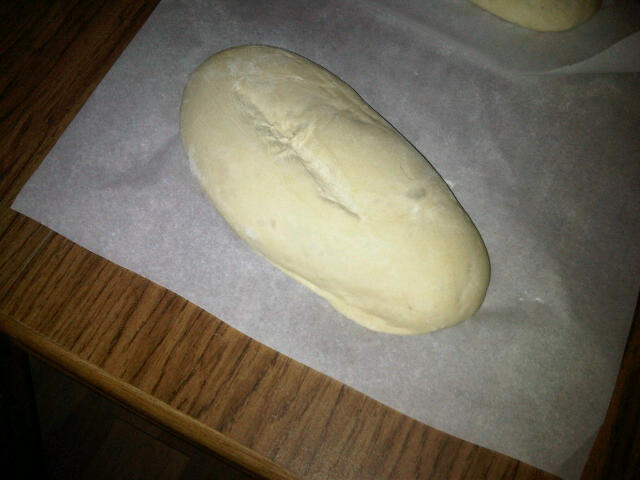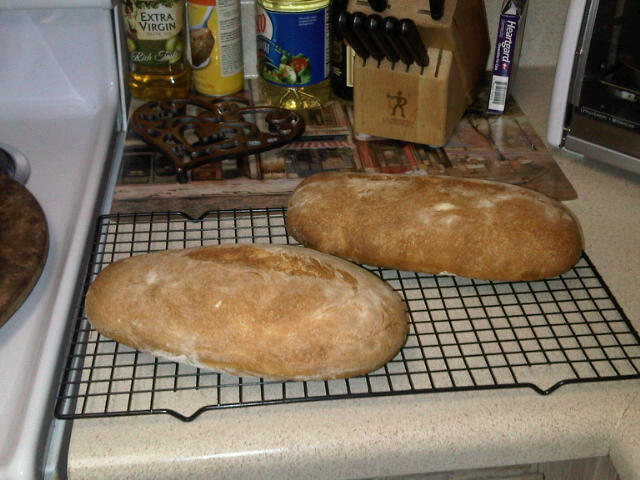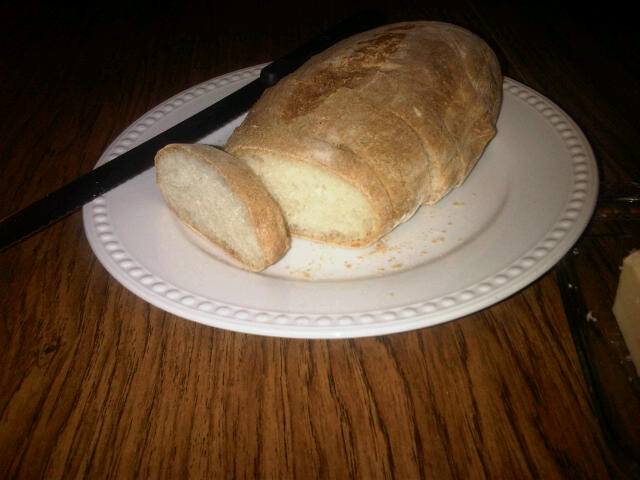Well, time passed in that way it does and soon I had two loaves ready for the oven:

I trimmed the parchment paper (which burned to a crisp, by the way, any tips on avoiding that in the future?), wished them well, and gently slid them on the stone.
Twenty minutes later, I pulled out these:

As you can see, they were far darker than I'd wanted. The recipe stated they should be a "pale golden," and I got, well, flour-ed brown. They came out crispy enough and the crust had some crackle, and the bottom sounded hollow enough.
But alas, it wasn't long before they were soft. I wondered if I shouldn't have tried spritzing them or something.
Still, when it came time for stew, the crumb was ok in the loaf we ate (haven't tried the second one yet), though not as bubbly as I had expected:

So, that's my ciabatta adventure. I'll definately try again, as I'm a tad disappointed in these loaves. Any tips for next time would be greatly appreciated.
- Shutzie27's Blog
- Log in or register to post comments
Well congratulations! I think they look pretty good myself, and flour on the loaf is kind of a "signature" for ciabatta because the dough is so wet you must use flour to manage it. When you have eaten this batch you can bake some more, or don't wait till it is gone. You can always give one away to someone.
As we all come to learn, ciabatta is a challenge. I just baked two different recipes of ciabatta (blog post here) and I also got results I was not totally thrilled with. You might want to read the comments by Wally (Larry) in that thread because you may find his advice as useful as I did.
I am not doing well enough on my ciabatta yet to give you advice, except to say that everything I read about accomplishing that large-hole crumb we expect of ciabatta points to dough as wet as you can manage, and an absolute minimum of handling as key elements to concentrate on.
As to the parchment paper, I always consider it expendable. Sometimes I can salvage it, and sometimes not. I usually manage to save it any time I am baking cooler, like rolls and such. When baking hot, as with hearth-style loaves like these, I expect it to crisp up and pretty much disintegrate. One thing that can help is to remove the parchment a little over half way through the bake, when the loaves are fully set up, and finish them directly on the stone or pan. That may get you an extra bake or two out of a sheet.
You have the right attitude: "I'll definitely try again...".
Good luck with it
OldWoodenSpoon
After reading your blog, I've already identified two problems with my loaves: 1.) I definitely did not have we enough dough and 2.) I probably over handled the dough when shaping the loaves. Both key factors to improve upon next time. So see? You can give ciabatta advice.
As for the parchment paper, I've never liked baking with it and will probably do away with it. I thought it was performing some kind of anti-burn function for the bottom (although, would it be terrible to use corn meal instead for that....?), but really, upon re-reading the recipe, I think it was just to assist with sliding the dough onto the stone. Also, my pizza stone is sorely used and battered, although that hasn't affected any of my bread to date.
I'm not sure how the glossiness of the crumb in a good ciabatta happens, but that also was certainly missing. So, as you say, another attempt soon to follow.
About that parchment paper: it usually serves many purposes, but the one you identified is my own most common reason for using it. It really does make it easier, especially for very wet dough, to move the dough from place to place. I have a Super Peel (TM) that is excellent for loading with, once you get the dough onto it. I sometimes need help from parchment to get the loaf that far without destroying it. If you want to get rid of the parchment, buy a small quantity of Semolina "flour" and dust your peel wellwith that before putting the loaf on it. It works like ball bearings to help the loaf slide off onto the stone. Bob's Red Mill brand is what I buy because my local markets carry it. It is a coarse grind of Durhum wheat with gorgeous color, many uses besides lubricating your peel, and has a significantly higher smoke point than corn meal. Corn meal will scorch, burn and emit nasty odors at common bread baking temperatures. Some also object to adding a corny taste to the bottom crust of everything.
That glossy finish inside the bubbles of the crumb is the result of gelatinizng the starches in the dough during baking. It is not just a "good thing" in ciabatta though. It is a desirable result in bread.
I look forward to your next effort. I'm sure you do too.
OldWoodenSpoon
I tried my hand at ciabatta this weekend and had a relatively good outcome. First, I used an overnight preferment. Then I added about 5% white whole wheat to the flour used. As a result, I got a nicely flavored group of ciabattini (small ciabatta) with what I thought was an attractive crumb. The evidence was consumed very quickly.
I think a longer preferment is definitely the way to go, Postal Grunt. I only had a slight hint of sourdough taste after about 16 hours.
I've been baking the same ciabatta for several years. Boring, but I'm good at it now. It takes many tries to know JUST how wet and sticky it can be without collapsing. I never use flour; I just form my boules after a last round of stretch and fold and let them rise on my bread baking pan (a sheet pan now black with baked-on oil).
For me, the trick is watching how the dough behaves when I am kneading it in the Kitchenaid. It should ball up, but stick at the bottom. No sticking, too dry. Slumps, too wet.
They came out crispy enough and the crust had some crackle, and the bottom sounded hollow enough.
But alas, it wasn't long before they were soft. I wondered if I shouldn't have tried spritzing them or something.
----
I have that happening to me when the crust gets soft. When you take the bread out of the oven, the crust is crispy. After a while, the steam and moisture from the bread softens the crust. Just re-bake the bread again, and it will be fine.